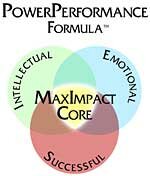“Personal energy is the single most valuable asset in business today.” Robin Sharma
Your people are your profits. Your business is successful (or not) because of the energy and engagement level of your employees. And as managers and leaders, you have the ability to influence this. You can’t control your employees’ energy and engagement, but you can inspire both.
Consider that “energy” is the degree of effort, and the attitude and outlook that an employee chooses to bring to work (it is a choice). Consider that “engagement” is the degree of interest, willingness and ability that an employee has in his work. So performance is then equal to the energy times the engagement – or, the effort times the interest.
Notice that we as managers have a greater ability to affect engagement more than energy because we can realign employees into roles to better connect them to their abilities. Employees, however, choose their energy levels. Improving this takes more specific effort than improving engagement.
To see how these attributes impact performance, draw a graph where the horizontal line is labeled “energy” and mark it low on the left, high on the right. Label the vertical line “engagement” and mark low on the bottom, high on the top. This is the engagement and energy grid that can be divided into four quadrants.
Quadrant 1: low energy, low engagement. These employees bring little to the job. They show up with neither effort nor interest – they have low energy about the job and don’t have the right abilities to do the job well. This is generally due to a job and culture that doesn’t fit the employee, and an employee who may be more negative, cynical and complaining – not just about the job. Which of your employees are here?
Quadrant 2: high energy, low engagement. These employees have a positive outlook and bring great energy to the workplace but they don’t succeed because their abilities don’t fit the abilities of the job (right attitude, wrong talents). Employees become disengaged when they don’t feel capable and competent (this can move them back to Quadrant 1 – low energy, low engagement). Realigning this employee to a job that better fits his abilities can make a significant different in performance. Which of your employees are here?
Quadrant 3: low energy, high engagement. These employees still have average performance because their effort level is low, though they connect with the work – they are interested in and likely good at it. These employees fit the job, but don’t have strong powerful personal energy. As in Quadrant 1, these employees are more negative, cynical and complaining – despite the fact that they like their jobs. Coaching is a sound response for these employees as it has the ability to help the employee change his energy level. Which of your employees are here?
Quadrant 4: high energy, high engagement. These are actively engaged employees. These employees have an anabolic and positive attitude, energy and personal standard of excellence, and are a good fit for the job. They show up ready to make a profound difference and should be coached to support their need to constantly learn, improve and add value. Which of your employees are here?
Working with employee energy shortages requires a different response than with an engagement shortage. Because employees choose their energy level (in work and life), many times the primary way to help a low energy employee is through coaching (with the manager or an outside coach). Coaching looks to identify and create responses to blocks to positive energy; an employee must see the need and commit the effort to change.
Engagement, on the other hand, can be addressed by realigning employees to roles that better suit their talents, strengths and passions. Engagement increases when employees feel capable, competent and interested in what they do.
Energy times engagement equals performance. Know how to help your employees increase their energy and their engagement. Increase both and performance rises.
Contact me to learn how coaching can help move your employees to Quadrant 4. More tools and ideas are at WorkFiredUp.com, your resource for hiring and retaining an A-level workforce.

 Most people don’t believe that it is possible to love your job – to love what you do and to be passionate about doing it. Most feel that work is how you make the money to have the life you want. But in today’s world the right job is one that plays to your strengths, activates your passions, allows for your best performance and adds great value to your life. Finding the right job is not complicated but it does require you to take the time to know your talents, strengths, passions and interests. There is no reason for you to hate your job; with a little direction, you can learn to define and hired into your dream job. Now is the time to find the right job and a job you love.
Most people don’t believe that it is possible to love your job – to love what you do and to be passionate about doing it. Most feel that work is how you make the money to have the life you want. But in today’s world the right job is one that plays to your strengths, activates your passions, allows for your best performance and adds great value to your life. Finding the right job is not complicated but it does require you to take the time to know your talents, strengths, passions and interests. There is no reason for you to hate your job; with a little direction, you can learn to define and hired into your dream job. Now is the time to find the right job and a job you love.